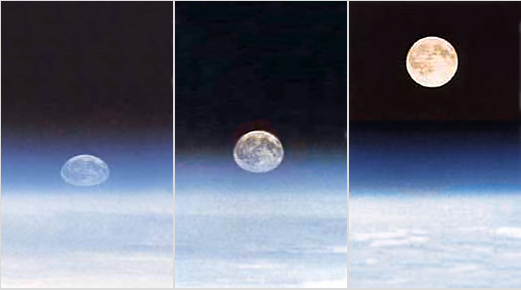Moonrise from Skylab
Moonrise from Skylab: A Captivating Perspective
As Earth's natural satellite, the Moon has captivated humanity for centuries. Its mesmerizing presence in the night sky has inspired countless poets, artists, and dreamers. However, have you ever wondered what a moonrise might look like from space? Thanks to the Skylab space station, we have been granted a unique and awe-inspiring glimpse of this celestial event.
Skylab, a precursor to the International Space Station, orbited the Earth from 1973 to 1979. During its mission, it provided astronauts with the opportunity to observe and document various atmospheric phenomena, including the moonrise. Through their lens, we can witness the magical journey of the Moon as it emerges above the horizon.
When observing a moonrise from Skylab, the Moon initially appears almost unrecognizable. Only its surface markings serve as a clue to its identity. This transformation is due to the interplay between moonlight and Earth's atmosphere. As the moonlight enters our atmosphere and then exits it, it traverses a path twice as long as that seen during a moonrise from the surface of our planet.
The journey of moonlight through Earth's atmosphere is not without its effects. One notable phenomenon is differential refraction, which occurs when different parts of the Moon's disk experience varying amounts of bending as they pass through the atmosphere. This refraction causes the lower limb of the Moon to be pushed upwards, resulting in a highly flattened appearance. It is this unique distortion that creates the mesmerizing shape we witness during a moonrise from Skylab.
Interestingly, this extreme distortion is not limited to space observations alone. If you find yourself aboard a high-flying aircraft during a moonrise or sunrise, you may witness a similar level of flattening caused by differential refraction. Although not as pronounced as the view from Skylab, it still offers a captivating and otherworldly experience.
The images of moonrises captured from Skylab are not only visually stunning but also provide valuable scientific insights. By studying these images, researchers can gain a deeper understanding of the Earth's atmosphere and its interaction with celestial bodies. They help us unravel the complexities of atmospheric optics and contribute to our knowledge of how light behaves as it passes through different mediums.
The ability to witness a moonrise from space offers a fresh perspective on this familiar celestial event. It reminds us of the vastness of our universe and the intricate interplay between Earth, the Moon, and our atmosphere. As we continue to explore space and push the boundaries of human knowledge, we can anticipate even more breathtaking images and discoveries that will continue to ignite our curiosity and expand our understanding of the cosmos.
So, the next time you gaze up at the Moon, take a moment to imagine what it would be like to witness a moonrise from Skylab. Let your mind wander among the stars and appreciate the beauty and wonder that lies beyond our earthly confines.
A silvery bubble rises through Earth's atmosphere.

A moonrise sequence from an earlier space station, Skylab. The Moon is at first almost unrecognisable but for its surface markings. Moonlight enters the atmosphere and then leaves again, a path length twice that in moonrises seen from Earth's surface. Differential refraction pushes the lower limb upwards to create the highly flattened shape. Look out for a moonrise (or sunrise) from a high flying aircraft, the distortion is almost as extreme.
Images courtesy NASA.
Note: this article has been automatically converted from the old site and may not appear as intended. You can find the original article here.
Reference Atmospheric Optics
If you use any of the definitions, information, or data presented on Atmospheric Optics, please copy the link or reference below to properly credit us as the reference source. Thank you!
-
<a href="https://atoptics.co.uk/blog/moonrise-from-skylab/">Moonrise from Skylab</a>
-
"Moonrise from Skylab". Atmospheric Optics. Accessed on April 18, 2024. https://atoptics.co.uk/blog/moonrise-from-skylab/.
-
"Moonrise from Skylab". Atmospheric Optics, https://atoptics.co.uk/blog/moonrise-from-skylab/. Accessed 18 April, 2024
-
Moonrise from Skylab. Atmospheric Optics. Retrieved from https://atoptics.co.uk/blog/moonrise-from-skylab/.